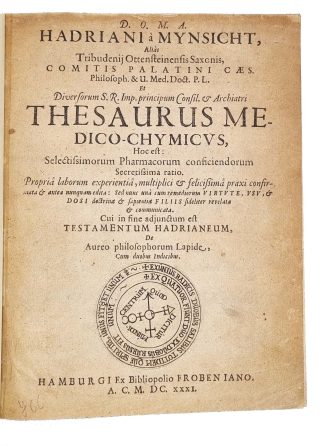MYNSICHT, Hadrian.
MEDICO-CHEMICAL PHARMACOPOEIA
Thesaurus Medico-Chymicus.
Hamburg, Ex Bibliopolio Frobeniano, 1631.£1,750.00
FIRST EDITION. 4to. 2 parts in 1, half-title to second, pp. [28], 395, [9]. Roman letter, with Italic. Engraved round vignette with alchemical diagram to title and half-title, full-page author’s engraved portrait to [*]4, decorated initials and ornaments. Uniform slight browning, upper edge trimmed short, very occasionally touching running title. A good, clean copy in modern paper boards, all edges sprinkled red, faint armorial dry-stamp to title and two others.
The scarce first edition of this popular compendium of medico-chemical remedies cum ‘book of secrets’. Hadrian Mynsicht (1603-38) was a German physician and chemist trained at Helmstadt, later personal doctor to sundry noblemen, including the Duke of Mecklenburg. Part ‘book of secrets’ part pharmacopoeia, ‘“Thesaurus” contains a description of the preparation of a number of medicines discovered by Mynsicht and still in use, in 1751, by the apothecaries. […] He was the first to prepare tartar emetic from roasted antimony sulphide and cream of tartar’ (Ferguson). Whilst following iatrochemical theories, i.e., the interpretation and study of medicine and physiology in chemical terms, Mynsicht also included a few Hermetic processes such as how to obtain the Philosopher’s Stone, as well as, ‘Unicornus solare’, ‘Luna potabilis’ and ‘Liquor Solis aromaticus’, from minerals. Each section presents a substance, one or more recipes to obtain it, and – under ‘Vires, Usus, Dosis’ (strength, use, dosage) – its effects for specific conditions and types of patients (e.g., ‘virgins and young women’). Among the sources cited are Du Chesne, Croll and Libavius. Mynsicht explains how to extract dozens of kinds of quintessence, pills, electuaries, balms, therapeutic wines, syrups and oils, e.g., from cinnamon, coral, deer antlers, as well as powders to treat epilepsy, gonorrhoea, incontinence, piles, impotence, teeth whitening (using ‘Farina virginea’), menstrual pain (with laudanum), fevers, backache, kidney stones, insomnia, the plague, gout, melancholy, mania, apoplexy, etc. Part II, called ‘Testamentum Hadrianeum’, reprises both the genres of the ‘testament’, used by alchemical and iatrochemical authors such as Paracelsus, Llull and Basil Valentin, and allegorical alchemical verse, being a Latin poem on the making of the Philosopher’s Stone, prefaced by one page on Hermes Trismegistus. An interesting work suspended between competing chemical theories.
Only Yale and NLM copies recorded in the US. USTC 2518993; VD17 23:290827A; Krivatsy 8243; Ferguson II, p.122; Duveen, p.421 (1651 ed.). Not in Wellcome, Osler or Heirs of Hippocrates.In stock




